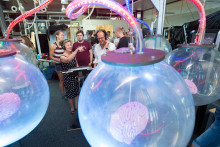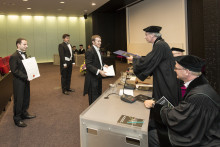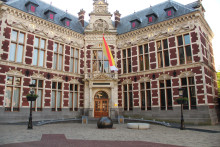To the uninitiated the DesignLab this afternoon would look a bit like a haunted house, with skulls, a Frankenstein head, and brains in transparent spheres coming at you from every corner. Although the mood was bright, the setting was not. The windows were half-blinded, there was a wall full of depressive thoughts, and a computer that kept typing ‘help’. Is this what the world will look like in 2218?
The brain network
‘That depends,’ says Paula Clemens Villa, one of the makers of the brain network, and definitely one of the most striking designs in the room. A large wooden structure provides the frame for five transparent spheres, each containing a brain, that are all connected by thick LED cables.
‘These brains have different personalities,’ Clemens Villa continues. ‘This one is a psycho, and the other a drama queen. With a headset, you can listen to their conversation, and with the switches you can select three brains. Your choice determines the course of the conversation and the outcome of the simulation. The brains change each other’s mood based on which emotion is dominant and thus you can steer the outcome of the discussion.’
This implies that we have some degree of control over a collective intelligence, whether we are talking about hooking up human brains, artificial intelligence, or both. This raises an interesting ethical dilemma: is it morally justified to experiment with self-aware artificial intelligence? On this very topic, the ‘Ctrl Why’ group focused their designs.

A suicide phone and depressed keyboard
Nathalie ten Broeke, one of the team members, explains their source of inspiration: ‘What if technology becomes indistinguishable from an organism, like a mouse?’ She shows me a computer mouse that is ‘running’ in a wheel and another one that is stuck in a cage and bumping into the walls in an attempt to escape. We proceed to the next design. ‘This keyboard might have post-traumatic stress disorder,’ Ten Broeke continues. ‘The keys are attached to fishlines so they are actually being pressed and on the screen, you can see that he is constantly typing HELP.’
My attention is drawn to a cell phone on a wall with depressive thoughts written all over it, and the instructions tell me to dial 1-1-3. The moment I type ‘3’, the phone detaches itself and literally hangs itself. Psychological evaluation: the phone suffers from depression and anxiety disorder.
GOGBOT
At one o’clock, the GOGBOT jury presented the results. This year, not only were there more participants than in previous editions (120 to 40), but the projects were also of such a high quality that everyone qualified for the GOGBOT festival, which has never happened before. The GOGBOT festival will be held at the Oude Markt in Enschede from 6-9 September, so if you want to see any of the designs in action, that’s the place to be.








